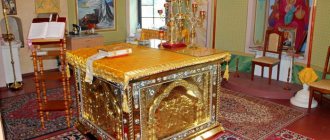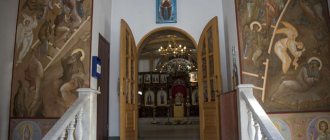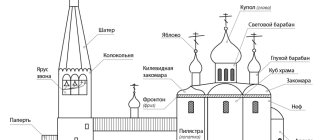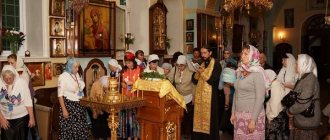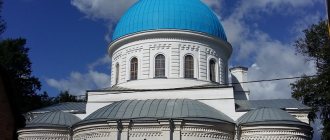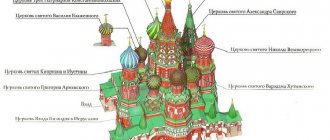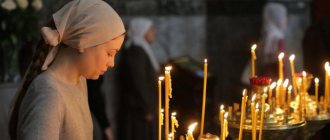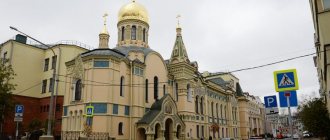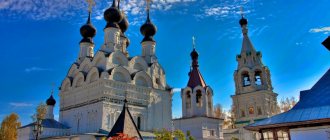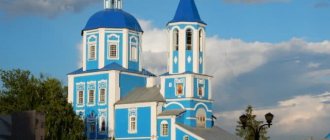Pulpit as a form of architectural art
Translated from Greek, “ambo” means a mountain ledge, climbing to the top.
Simeon of Thessalonica - Archbishop of Thessaloniki in the 15th century. He wrote that the pulpit in the temple is the stone of the Holy Sepulcher, from which priests and deacons, like angels, bring good news to the people in the temple. (Source: Chapter 18 of the Book of the Temple)
“Books about the Temple” by St. Simeon of Thessalonica
Pulpits were first mentioned in the canons of the Council of Laodicea in 364. There is little information about them. In rich churches - for example, Hagia Sophia, they were huge. Sometimes pulpits were carved from a single piece of marble. The oldest example of this type is the Solunsky sample, which now exists in the form of two large pieces of marble. If you put them together, it will be more than 5 meters. It had the shape of a semicircular tower.
The pulpit was built of marble and decorated with carvings, gold and sculptural mosaics. It became part of the soleya only in the 17th century.
Pulpit in the Cathedral of Salerno, Italy, 1180
Why aren't women allowed in?
From the Old Testament names there is a ban on bringing blood other than sacrificial blood into the Holy of Holies. Since the essence of the Christian liturgy is the Sacrifice of the Body and Blood of the Son of God, this prohibition continues to apply. According to Rule 44 of the Council of Laodicea (360), women are prohibited from entering the altar “for reasons of involuntary menstruation.” However, sometimes being here to help during worship is possible. Usually, with a special blessing, the following are allowed:
- elderly nuns - this happens especially often in monasteries;
- During the persecutions of the Soviet years, older parishioners also sometimes helped the priests of parish churches.
Solea - the place where the pulpit is located
Solea is a semicircular platform in front of the altar floor. It is raised above the main level of the church. On the sides of the solea, on the choirs, there are singers or readers. In some churches there is no choir on the sole.
Scheme of the altar part of the temple. Please note that the soleya occupies the entire width of the temple.
The practical meaning of the sole is a convenient elevation to bear the Holy Scriptures. The minister takes the Gospel from the Throne, carries it out along the salt, and returns it to its place through the Royal Doors.
There is such a concept: “a candle for the altar” - what is the meaning?
This is a donation to the temple, which is made by the parishioner whenever possible. There are candles burning on the throne, standing on the altar. In addition, priests stand with candles during the All-Night Vigil when the Gospel is read. Such candles are either purchased by the temple or donated by zealous parishioners.
The Throne of God and Golgotha, the place where Angels concelebrate with earthly clergy - this is the heart of any Orthodox church, even the most modest one.
Natalia Sazonova
Greek pulpit in Rus'
In Rus', pulpits were most often built according to Byzantine drawings from the 12th century. Such an ancient Russian pulpit of the St. Sophia Cathedral in Novgorod has been preserved.
General view of the pulpit of 1533 from the Hagia Sophia Cathedral (Sophia Cathedral) of Veliky Novgorod before restoration. Height - 300 cm, circumference - 600 cm
Now it is the only surviving free-standing wooden pulpit of the Byzantine Orthodox tradition in the world.
It looked like a round gazebo with one entrance. It was supported by a column arch, almost human height. It was decorated with flowers and patterns.
The pulpit was built of wood and performed many functions - the most important hymns were sung there, the sacred texts of the Gospel and the Apostle were read.
The sacred rite “Elevation of the Cross” was performed there. The structure has survived to this day, but now you can only see it in the State Museum of St. Petersburg.
The pulpit of the St. Sophia Cathedral is being restored at the Russian Museum in 2014
Architectural features of temple buildings
A temple is a consecrated building in which Divine services are performed, and believers have the opportunity to take part in the Sacraments. Traditionally, the main entrance to the temple is located in the west - where the sun sets, and the main liturgical part - the altar - is always located in the east, where the sun rises.
Prince Vladimir Church in Irkutsk
You can distinguish a Christian church from any other buildings by its characteristic dome (head) with a cross. This is a symbol of the Savior’s death on the cross, Who voluntarily ascended to the Cross for our redemption. It is no coincidence that the number of heads on each church is:
- one dome signifies the Commandment of the unity of God (I am the Lord your God, and you will have no other gods besides Me);
- three domes are erected in honor of the Holy Trinity;
- the five domes symbolize Jesus Christ and His four evangelists;
- seven chapters remind believers of the seven main Sacraments of the Holy Church, as well as the seven ecumenical councils;
- Sometimes there are buildings with thirteen chapters, which symbolize the Lord and the 12 apostles.
Important!
Any temple is dedicated, first of all, to our Lord Jesus Christ, but at the same time it can be consecrated in honor of any saint or holiday (for example, the Church of the Nativity, St. Nicholas, Intercession, etc.). About Orthodox churches:
- Church of the Presentation of the Lord in St. Petersburg
- Church of Seraphim Vyritsky in Vyritsa
- St. Isaac's Cathedral in St. Petersburg
When laying the foundation stone for a temple, one of the following figures may be laid in the foundation:
- cross (signifies the instrument of the Lord’s death and the symbol of our salvation);
- rectangle (associated with Noah's Ark as a ship of salvation);
- circle (meaning the absence of beginning and end of the Church, which is eternal);
- a star with 8 ends (in memory of the Bethlehem star, which pointed to the birth of Christ).
Top view of the Church of Elijah the Prophet in Yaroslavl
Symbolically, the building itself correlates with the ark of salvation for all mankind. And just as Noah many centuries ago saved his family and all living things on his ark during the Great Flood, so today people go to church to save their souls.
The main liturgical part of the church, where the altar is located, faces east, since the goal of human life is to go from darkness to light, and therefore from west to east. In addition, in the Bible we see texts in which Christ himself is called the East and the Light of Truth coming from the East. Therefore, it is customary to serve the Liturgy at the altar in the direction of the rising sun.
The purpose of the pulpit in the temple is a place for reading the Bible and the Apostle
The deacons stand on the pulpit and read the books of the Old and New Testaments. Why is the pulpit located in this particular place - on a hill, near the central dome?
The fact is that this place has good acoustics.
Basilica of St. Clement and Lawrence in Italy. It is interesting because there are two pulpits - on the right side and on the left. One of them is used for reading the Gospel, the other for reading the Apostle
Sometimes two pulpits were combined into one two-story pulpit. One such example is in the Church of St. Stamp in Venice.
They look like a large and a small gazebo. Sometimes large candlesticks are added to the pulpit, in the form of twisted columns and latticework for fencing.
St. Mark's Cathedral, 14th century. Two-tier pulpit
What does the temple look like from the outside?
Assumption Cathedral of the Moscow Kremlin Illustration by Galina Krebs
Usually a temple is made up of several clearly distinguishable elements. The altar part adjoins the main volume from the east. On the outside, these are semicircular extensions - apses. There may be one, three or five such extensions. From above, above the main volume of the temple, you can see one or more drums - these are round or multifaceted towers with windows through which the temple is illuminated from the inside. The drums end with a hemispherical dome - but from the outside we see not it, but the heads of the Orthodox church - this is the covering of the domes that end the drums. Sometimes the term "chapter" or "head" also refers to the drum that carries it. In colloquial speech, chapters are often called domes. various shapes - helmet-shaped or bulbous. Unlike the dome, which is the most important part of the building structure, the chapters do not carry a structural load: they are a decorative covering that protects the floors from rain or snow. The heads are crowned with crosses.
The entrance can be directly from the porch, the area in front of the entrance, or through various extensions - porches, walkways. Gulbishche is a circular gallery raised to the floor level of the main tier of the temple. To prevent parishioners from crowding, refectories are attached to the main room. In addition, the composition of the temple may include bell towers and belfries. A bell tower is a multi-tiered tower, free-standing or attached to the temple, with bells and a platform for the bell-ringer. A belfry is a wall built for the same purpose. The bells are located in special through openings at a height, and are controlled from below - from the temple or from the ground.
Bishop's pulpit
In the first churches, in the middle part of the temple there was a bishop's pulpit. Another name is locker. It symbolized the mountain from which Jesus Christ spoke his Sermon on the Mount. Now the bishop's pulpit may stand a little further south.
Sometimes it was called the “place of clouds”—the bishop dressed there. Another name is “prepared place.” He was elevated according to the status of a priest, mainly by two levels. But when they consecrate bishops, the locker is raised from 4 to 6 steps. At this unique pulpit, funeral services, prayer services, and royal hours ended.
Bishop's pulpit in the St. Nicholas Convent. It differs from a regular pulpit in that it has a pulpit.
Internal structure of an Orthodox church
The Lord Himself gave people in the Old Testament, through the prophet Moses, instructions on what a temple should be like for worship; The New Testament Orthodox church is built according to the model of the Old Testament.
The New Testament Orthodox church is built on the model of the Old Testament
How the Old Testament temple (in the beginning – the tabernacle) was divided into three parts:
- holy of holies,
- sanctuary and
- yard
,
– and the Orthodox Christian church is divided into three parts:
- altar,
- the middle part of the temple and
- porch
.
Like the holy of holies then and now the altar
means the Kingdom of Heaven.
In Old Testament times, no one could enter the altar. Only the high priest once a year, and then only with the blood of a cleansing sacrifice. After all, the Kingdom of Heaven was closed to man after the Fall. The high priest was a prototype of Christ, and this action of his signified to people that the time would come when Christ, through the shedding of His blood and suffering on the cross, would open the Kingdom of Heaven to everyone. That is why when Christ died on the cross, the curtain in the temple that covered the Holy of Holies was torn in two: from that moment on, Christ opened the gates of the Kingdom of Heaven for all who come to Him with faith.
The middle part of the New Testament temple corresponds to the Old Testament sanctuary
The middle part of the temple corresponds to the sanctuary in our Orthodox church
. None of the people had the right to enter the sanctuary of the Old Testament temple, except the priests. All Christian believers stand in our church, because now the Kingdom of God is closed to no one.
The courtyard of the Old Testament temple, where all the people were, corresponds to the narthex
, now of no significant importance. Previously, catechumens stood here who, while preparing to become Christians, had not yet received the sacrament of baptism. Now, sometimes those who have seriously sinned and apostatized from the Church are temporarily sent to stand in the vestibule for correction.
Catechumens are people preparing to become Christians
Orthodox churches are built with the altar facing east
– towards the light, where the sun rises: the Lord Jesus Christ is the “east” for us, from Him the eternal Divine Light has shone for us. In church prayers we call Jesus Christ the “Sun of Truth”, “from the heights of the East” (that is, “East from above”), “His name is East.”
Each temple is dedicated to God, bearing a name in memory of one or another sacred event or saint of God, for example, Trinity Church, Transfiguration, Ascension, Annunciation, Pokrovsky, Michael-Arkhangelsk, Nikolaevsky, etc. If several altars are installed in the temple, each of They are consecrated in memory of a special event or saint. Then all the altars, except the main one, are called side altars
, or
chapels
.
There may be several altars in a temple
A temple (“church”) is a special house dedicated to God - the “House of God” in which services are performed. In the temple there is a special grace or mercy of God, which is given to us through those performing divine services - clergy (bishops and priests).
The external appearance of the temple differs from an ordinary building in that a dome
, depicting the sky.
The dome ends at the top with a
on which
a cross
, in honor of the head of the Church - Jesus Christ.
Often, not one, but several chapters are built on a temple, then
- two heads mean two natures (Divine and human) in Jesus Christ;
- three chapters - three Persons of the Holy Trinity;
- five chapters - Jesus Christ and the four evangelists,
- seven chapters - seven sacraments and seven Ecumenical Councils;
- nine chapters - nine ranks of angels;
- thirteen chapters - Jesus Christ and the twelve apostles.
Sometimes more chapters are built.
A bell tower is usually built above the entrance to the temple
, that is, the tower on which the bells hang. The ringing of bells is necessary in order to call believers to worship and to announce the most important parts of the service performed in the church.
a porch outside
(platform, porch).
Inside the temple is divided into three parts:
- porch
, - the temple itself or the middle part of the temple
where those praying stand, and - altar
, where the clergy perform services and the most important place in the entire temple is located -
the holy altar
, on which the sacrament of Holy Communion is performed.
The altar is separated from the middle part of the temple by an iconostasis
, consisting of several rows
of icons
and having three
gates
: the middle gate is called
the Royal Gate
, because through them the Lord Jesus Christ Himself, the King of Glory, invisibly passes in the Holy Gifts (in holy communion). Therefore, no one is allowed to pass through the royal doors except the clergy.
The iconostasis is needed to separate the altar from the middle part of the temple
The reading and singing of prayers performed according to a special rite (order) in a temple headed by a clergyman is called a divine service.
.
The most important service of worship is the liturgy
or
mass
(it takes place before noon).
Because the temple is a great holy place
where
God Himself
, then we must enter the temple with
prayer
and keep ourselves in the temple
quietly
and
reverently
.
You cannot turn your back to the altar. You should not leave
the temple until the end of the service.
So you enter the temple. You have passed the first doors and entered the porch
, or refectory. The porch is the entrance to the temple. In the first centuries of Christianity, penitents stood here, as well as catechumens (that is, persons preparing for holy baptism). Now this part of the temple does not have the same importance as before, but even today, sometimes those who have seriously sinned and apostatized from the church temporarily stand in the vestibule for correction.
Having entered the next doors, that is, having entered the middle part of the temple, an Orthodox Christian must make the sign of the cross three times.
When entering the middle part of the temple, you must cross yourself three times
The middle part of the temple is called the nave
, that is, a ship, or
a quadruple
.
It is intended for the prayer of the faithful or those who have already been baptized. The most notable thing in this part of the temple is the solea
, as well as
the pulpit, choir
and
iconostasis
.
The word solea
is of Greek origin and means seat.
This is the elevation in front of the iconostasis
. It is arranged so that the worship service is more visible and audible for parishioners. It should be noted that in ancient times the solea was very narrow.
Solea is a platform, an elevation in front of the iconostasis
The middle of the solea, opposite the Royal Doors, is called the pulpit
, i.e. by ascent. At the pulpit, the deacon pronounces litanies and reads the Gospel. On the pulpit, Holy Communion is also given to believers.
Choirs
(right and left) are the extreme sections of the solea, intended for readers and singers.
Banners
are attached to the choirs , that is, icons on poles, called church banners.
An iconostasis
is a wall separating the nave from
the altar
, all hung with icons, sometimes in several rows.
In the center of the iconostasis are the Royal Doors
located opposite the throne.
They are called so because through them the King of Glory Jesus Christ Himself comes out in the Holy Gifts. The Royal Doors are decorated with icons depicting them: the Annunciation of the Blessed Virgin Mary
and
the four evangelists
, that is, the apostles who wrote the Gospel: Matthew, Mark, Luke and John.
of the Last Supper
is placed above the royal doors .
of the Savior is always placed to the right of the royal doors
, and to the left is the icon
of the Mother of God
.
To the right of the icon of the Savior is the southern door
, and to the left of the icon of the Mother of God there is
a northern door
.
On these side doors are depicted the archangels Michael and Gabriel
, or the first deacons Stephen and Philip, or the high priest Aaron and the prophet Moses.
The side doors are also called deacon's gates
, since deacons most often pass through them.
Further, behind the side doors of the iconostasis, icons of especially revered saints are placed. The first icon to the right of the icon of the Savior (not counting the southern door) should always be the temple icon
, that is, an image of that holiday or that saint in whose honor the temple was consecrated.
In the Russian tradition, high iconostases are adopted, often consisting of five tiers
- In the first tier on the Royal Doors there are icons of the Annunciation and the four evangelists; on the side gates (northern and southern) there are icons of archangels. On the sides of the Royal Doors: on the right is the image of the Savior and the temple festival, and on the left is the Mother of God and the icon of a particularly revered saint.
- In the second tier - above the Royal Doors - is the Last Supper, and on the sides are icons of the twelve feasts.
- In the third tier - above the Last Supper - the Deesis icon, or prayer, in the center of which is the Savior sitting on the throne, on the right is the Mother of God, on the left is John the Baptist, and on the sides are icons of prophets and apostles stretching out their hands to the Lord in prayer . To the right and left of the Deesis are icons of saints and archangels.
- In the fourth tier above the “Deesis row”: icons of the Old Testament righteous - the holy prophets.
- In the fifth tier is the God of Hosts with the Divine Son, and on the sides are icons of the Old Testament patriarchs. At the very top of the iconostasis there is a cross with the Mother of God and St. John the Theologian standing on either side.
The number of tiers may vary in different temples.
At the very top of the iconostasis there is a cross
with the image of our crucified Lord Jesus Christ on it.
In addition to the iconostasis, icons are placed on the walls of the temple, in large icon cases
, that is, in special large frames, and are also located on
lecterns
, that is, on special high narrow tables with an inclined surface.
Icon is a special large frame for an icon
Altar
churches are always facing the east to commemorate the idea that the church and worshipers are directed toward the
“east from above
,” that is, toward Christ.
The altar is the main part of the temple, intended for the clergy and the persons who serve them during worship. The altar represents heaven, the dwelling place of the Lord himself. Due to the especially sacred significance of the altar, it always inspires mysterious reverence, and upon entering it, believers must bow to the ground, and persons of military rank must remove their weapons. In extreme cases, not only church ministers, but also laymen - men - can enter the altar with the blessing of the priest.
In the altar, divine services are performed by the clergy and the most sacred place in the entire temple is located - the holy altar
, where the sacrament of Holy Communion is performed. The altar is placed on a raised platform. It is higher than other parts of the temple, so that everyone can hear the service and see what is happening in the altar. The very word “altar” means “exalted altar.”
The throne is a specially consecrated quadrangular table, located in the middle of the altar and decorated with two clothes: the lower one - white, made of linen, and the upper one - made of more expensive material, mostly brocade. The Lord Himself is mysteriously and invisibly present on the throne as the King and Lord of the Church. Only clergy can touch and kiss the throne.
On the throne are: an antimension, a Gospel, a cross, a tabernacle and a monstrance.
Antimens
is called a silk cloth (shawl) consecrated by the bishop with an image on it of the position of Jesus Christ in the tomb and, necessarily, with a particle of the relics of some saint sewn on the other side, since in the first centuries of Christianity the Liturgy was always performed at the tombs of martyrs. Without an antimension, the Divine Liturgy cannot be celebrated (the word “antimension” is Greek, meaning “in place of the throne”).
For safety, the antimins is wrapped in another silk board called iliton.
. It reminds us of the sir (plate) with which the Savior’s head was wrapped in the tomb.
On the antimind itself there is a lip
(sponge) for collecting particles of the Holy Gifts.
Gospel
- this is the word of God, the teaching of our Lord Jesus Christ.
Cross
- this is the sword of God, with which the Lord defeated the devil and death.
Tabernacle
called the ark (box) in which the Holy Gifts are stored in case of communion for the sick. Usually the tabernacle is made in the form of a small church.
Behind the throne stands a seven-branched candlestick
, that is, a candlestick with seven lamps, and behind it
an altar cross
.
The place behind the throne at the very eastern wall of the altar is called the mountain
(high)
place
; it is usually made sublime.
monstrance
called a small reliquary (box), in which the priest carries the Holy Gifts for communion with the sick at home.
To the left of the throne, in the northern part of the altar, there is another small table, also decorated on all sides with clothes. This table is called an altar
. Gifts for the sacrament of Communion are prepared on it.
sacred vessels on the altar
with all accessories. All these sacred objects must not be touched by anyone except bishops, priests and deacons.
The sacristy is located on the right side of the altar
. This is the name of the room where vestments are stored, that is, sacred garments used during worship, as well as church vessels and books with which worship is performed.
There is also an eve
, this is the name of a low table on which there is an image of the crucifixion and a stand for candles. Before the eve, memorial services are served, that is, funeral services for the dead.
Candlesticks stand in front of the icons and lecterns
, on which believers place candles.
In the middle of the temple, at the top of the ceiling, hangs a chandelier
, i.e. a large candlestick with many candles. The chandelier is lit during solemn moments of the service.
Now about the bells. They belong to the items of church utensils. Bells began to be used in the 7th century, during the time of persecution of Christians. Before this, the time for worship was determined through verbal announcements by the performers of the service, or Christians were called to prayer by special persons who went from house to house with announcements. Then, for the call to worship, metal boards called beats
or
rivets
, which were struck with a hammer.
In the 7th century, bells appeared in the Italian region of Campania; Therefore, bells are sometimes also called campans.
In the Russian church, 5 or more bells of various sizes and different tones are usually used for ringing. The ringing itself has three names:
- blagovest,
- ringing
and - chime.
Chime
- slowly ringing each bell in turn, starting with the largest and ending with the smallest, and then ringing all the bells simultaneously. Chime is usually used in connection with a sad event, for example, when carrying the dead.
Blagovest - ringing one bell.
Trezvon is the ringing of all bells, expressing Christian joy on the occasion of a solemn holiday and the like.
Nowadays it is becoming a custom to give bells the sounds of a scale, so that their ringing sometimes produces a certain melody. The ringing of bells increases the solemnity of the service. There is a special service to consecrate the bells before raising them to the bell tower.
A bell tower is built above the entrance to the temple, and sometimes next to the temple
, or
belfry
, that is, a tower on which bells hang.
Bell ringing is used to call believers to prayer, to worship, and also to announce the most important parts of the service performed in the church.
Material created: 06/01/2015
Scheme of an Orthodox church
Code of honor of a Russian entrepreneur
How ancient Russian temples were built
In just the first hundred years after baptism, Kievan Rus raised its own architects who knew how to burn brick and lay out walls, arches and vaults from it. Almost immediately, the appearance of the temples - even those built by the Greeks - began to differ from the Byzantine models. It became more holistic: elements of Byzantine churches lived their own lives, while parts of ancient Russian churches were inseparable from the overall composition. By the 12th century, each principality had its own construction teams, and buildings in different parts of Rus' received their own stylistic differences. At the same time, Western European artels could also operate in Rus' (at least in the Vladimir-Suzdal Principality). In these cases, the design and composition of the buildings remained Eastern Christian, but in the decorative design of the facades it is easy to notice the features of the Romanesque style that was then dominant in the West.
Constantinople masters taught ancient Russian builders to use a special brick - plinth, known since the times of Ancient Rome. Plinfa is a relatively thin ceramic slab that is convenient to dry and fire. In the 12th century, another ancient technology came from the West. The outer surfaces of each wall were laid out from carefully hewn limestone, and the gap was filled with mortar with stone scrap. For example, white stone churches were built in the Vladimir-Suzdal principality.
The main building material in Rus' has always been wood, and wooden architecture had a great influence on stone architecture. Some compositional techniques that became popular in stone buildings in the 16th–17th centuries could be perceived not as newly invented or adopted from the construction practice of other countries, but as a continuation of the domestic tradition of wooden architecture. Among such techniques are hipped ceilings, as well as an octagon on a quadrangle - an effective combination of a square volume at the bottom and an octagonal prism installed on it.
How did the cross-dome system come about?
Transfiguration Cathedral in Pereslavl-Zalessky Illustration by Galina Krebs
The first builders and teachers of local craftsmen were Byzantines and craftsmen from countries under the influence of Constantinople. In the East Roman Empire (that is, in Byzantium), by the end of the first millennium AD, that type of Orthodox church had already developed, which is still the main one in the East Slavic lands - with an inscribed cross in the plan, with domes under the domes raised on drums, and with a cross-dome design. Such temples went back to an even more ancient type of building - Roman basilicas, large covered forums. It was the basilica - an oblong building intended for court hearings, where the judge's chair was located in a special semicircular apse extension - that Christians of the first centuries took as a model, when they were allowed to build their own sacred buildings.
What changed after the Horde
Russian church architecture has never abandoned the cross-dome system; it is still used in large buildings today. However, in small temples, pillarless structures were more often used, that is, those in which the vaults rest directly on the walls, rather than on columns or pillars inside the building. Such monuments were also created in the pre-Mongol period, but in the 16th and 17th centuries there were many more of them. One of these constructive solutions was hipped ceilings, which gave the Orthodox church a pro-Western look associated with Gothic. In the 50s of the 17th century, Patriarch Nikon banned such compositions as not in accordance with Byzantine traditions. Another way to do without internal supports is to complete a square volume with a closed vault or its derivatives, similar to a skullcap. Decorative domes were placed on top of such a vault, most often on blind, windowless drums.
To expand the space, refectories began to be added to churches. If in monasteries this was the name given to rooms for eating with small built-in churches, then in this case, on the contrary, an additional structure was added to the temple, where no one had meals, but the name was preserved.
What mosaics and paintings tell us
Fatherland. Dome of the Archangel Cathedral of the Moscow Kremlin Illustration by Galina Krebs
If the horizontal axis of the temple symbolizes the spiritual path of a Christian, then the vertical axis reflects the sacred structure of the world. At the very top, in the dome of the central drum, there is an image of Christ Pantocrator (in Greek - Pantocrator), that is, the Lord of the world. At a later time, especially in the 17th century, another iconography was used - “Fatherland”: with God the Father, God the Son and the Holy Spirit. Prophets and apostles are depicted below. If the design of the temple is cross-domed (see below), there are four sails on it. Sails, or pandantives, are architectural details in the form of triangles concave on both sides. The sails transfer the weight of the dome and drum from the under-dome ring to the point supports. four evangelists are placed, and on the supports the Supports are, in architectural terminology, any free-standing pillars and columns. - pillars of the Church: martyrs, saints and saints. The main events of sacred history are depicted on the southern, eastern and northern walls. On the western wall opposite the altar, that is, where the exit is, there are frightening paintings of the Last Judgment (it turns out that they serve as a reminder for those who leave the temple). The apse of the altar, on the contrary, is dedicated to the brightest aspects of Christian doctrine - the sacrament of the Eucharist (thanksgiving, communion), in which the apostles and the Mother of God participate.
